Menus
- A mythical name, a good big 76 horsepower V-Twin
- Digital dashboard, starting aid, Easy Start system
- Discovery
- In the saddle
- In the city
- On highways and expressways
- On departmental
- Part-cycle
- Brakes
- Comfort / duo
- Consumption
- Conclusion
A mythical name, a good big 76 horsepower V-Twin
Digital dashboard, starting aid, Easy Start system
With its 650 cc V-Twin, Suzuki has enjoyed real industrial success since its creation. This block was produced in no less than 410,000 copies ! Appeared in 1999, with carburettors and Euro I standards, the Suzuki SV 650 and its V-Twin immediately obtained media recognition, with some lyrical journalists not hesitating to compare its mechanics, in terms of sensations, to the sculptural Ducati 996. We have known less flattering praise.
The rest looks like a great success story. 2000: the SV 650 is the second best seller in Europe, which is not a big deal, because the first is the Suzuki Bandit 600. In 2003, the SV 650 goes to injection and to the Euro II standard , the V-Strom made its arrival in stride and the commercial success is still there.
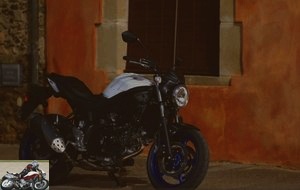
In 2009, the Euro III standard made its appearance on this block which powers, no longer the SV, but the Gladius. There, it becomes more complicated: not that the bike is bad, on the contrary its V-Twin, always valiant, is rather more pleasant to live than the engines of the competition. But a conjunction of factors surrounds the Gladius with negative waves: a questionable (and discussed) "feminine" design, a finish that gives pride of place to plastic, a curious name (Gladius, the Roman sword of victory!), A positioning marketing targeting too openly a female audience, bizarre colors (too kitsch, the pink from the start!). In short, that was a lot for a machine that was easy to learn and use..
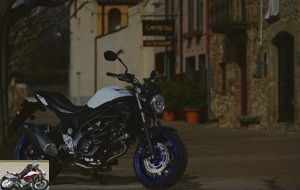
For the next stage, Suzuki therefore changes strategy: the name SV symbolizes the return to a glorious era and the bike is intended to be more sporty, by the contrast between sober paintings featuring a "Carol Shelby-style" band on the tank and a black trim on the frame and controls (handlebars, triple clamp). Compared to a Gladius, which acts as an organ donor, the evolution is more sensitive than it seems, with more than 60 modifications on the engine and 80 on the chassis, which gives a machine lighter by 8 kilos and more powerful by 4 horsepower (see technical file on the SV650).
Suzuki thus claims the mid-size roadster which is both the most accessible on the market by its handling, while also being the most powerful (this is, however, to disregard the Hyosung Comet 650 which claims to 85 hp, even if this one knows anecdotal sales in France). Other arguments of the SV 650 2016: a fully digital dashboard and two innovations, Suzuki Easy Start and Low RPM Assist.
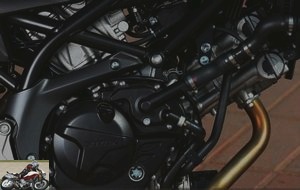
Discovery
Since 1999, we have had time to contemplate this V-Twin! Suzuki wanted to give a "timeless" look to its SV and, in full Youngtimers fashion, the approach is resolutely determined! So, in a world where all the competitors seek to position themselves in a spectrum that goes from neo-retro to futuro-manga-style, the SV is itself. Peinarde. A large, apparent V-Twin hanged on a sturdy trellis frame. A round headlight and a big exhaust on the side like the big bikes before. And shoo! “Hi, I’m the SV,” she says loudly to the biker crowd gazing at her, but she actually doesn’t have to introduce herself. OAS is a safe bet. Bikers who seek appearance and novelty at all costs will be at their cost.
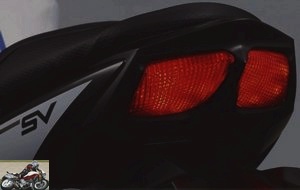
In the saddle
As we saw in our technical article, the new SV has gone to great lengths to make itself more accessible. They are not in vain: the seat height of 785 mm, the lowest in its segment, makes it effectively accessible to as many people as possible and the work done to thin the tank and the saddle to the crotch is paying off. If, visually, the SV 650 is not a slim fast motorcycle with its big V-Twin, its round headlight and its consequent dimensions, it is indeed easy to access and a rider of average size will put both feet by Earth.
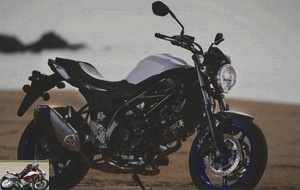
Well seated, we have plenty of time to contemplate the new environment offered by Suzuki: the contrasting color stripe on the tank, the triple clamps and black handlebars, it’s very sporty, all of that. The brake lever is adjustable, not the clutch. The commodos are simple, with a command for warnings on the left.
We then notice the new dashboard, fully digital and very complete (water temperature, fuel gauge, gear indicator engaged, two trips, range indicator, average and instantaneous consumption …) and it is rewarding . What is less, by widening the look, is the care taken in the finish. Suzuki wanted to make the SV 650 a light motorcycle and, indeed, 8 kilos were gained on the Gladius, with a full weight of weight which goes from 205 to 197 kilos. Result: the radiator is visible, with a coarse mounting plate on the left and its filler cap on the right surmounting the fan. It’s gross. Some would say not elegant. Suzuki could have put a nice plastic cover to hide the misery. But a cache is extra weight ….
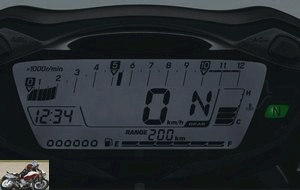
But some bikers prefer to look at what’s under the hood rather than causing rags. Contact. One push (with the Easy Start system, one push is enough and now you no longer need to actuate the clutch) on the starter and the V-Twin snorts in its characteristic sound, deep and deep and ( subjectively) nobler than that of the parallel twins with their jerky clicks. A few shots of empty gas demonstrate a low mechanical inertia and a sound which becomes pleasantly mechanical beyond 5000 rpm.
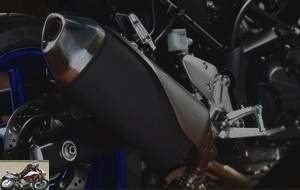
In the city
Thin and easy to grasp, the SV 650 will be at home in the city. Suzuki has developed an innovation for this model: the starting aid called Low RPM Assist. The principle is simple: when sensors detect a starting phase, they increase the engine speed at the point of engagement of the clutch to avoid the risk of stalling. You might think that the system is like a gadget like the Japanese sometimes know how to lay it to us: it is not. !

Because, indeed, a gentle dosage allows you to start the SV 650 on a hill without putting on gas. Obviously, it is still possible to stall by releasing the clutch like a piglet, but with a minimum of dosage, the starting maneuver remains greatly facilitated. And since the system is transparent to use, this is ultimately a useful technology that beginners will appreciate even more.
Once underway, we (re) discover the roundness of the V-Twin, capable of picking up in third just above idle speed, or crossing villages in fourth, at 50 km / h, at 3,000 rev / mn, smoothly.
The controls are smooth and don’t call for criticism. As for the braking, it is also soft, progressive and easily dosed..
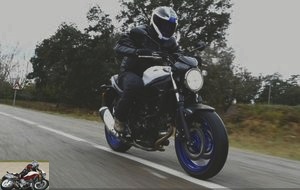
On highways and expressways
With 76.5 horsepower, the SV 650 is not afraid of long distances. Stalled at 130 in sixth, the V-Twin then turns at 5,800 rpm, in a deep roar and has the good taste not to distill vibrations. The stability is impeccable.
On the handlebars, the lack of protection is really noticeable above 140 km / h. The new saddle being well hollowed out, it is possible to shift backwards to easily opt for a speed search position.
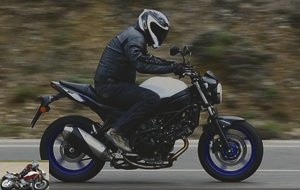
On departmental
The V-Twin spins at 4,000 rpm in sixth at 90 km / h. Suzuki has reworked the torque curve of this engine, compared to the Gladius which was already not particularly soft. We thus end up with a pleasant V-Twin, ringing true and full at all speeds, a pleasant ride companion as long as the gearbox is precise and locks well..
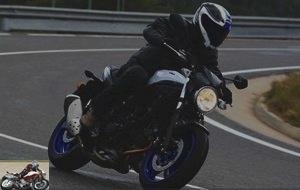
Many bikers think the V-Twin is the best type of engine that can fit a motorcycle, and as you go along with the SV, you have to admit that distilled pleasure is genuinely pleasurable across a wide spectrum of motorcycles. use.
Higher in the towers, the V-Twin reveals a second temperament, with a burst of power from 8 to 10,000 rpm, a small surplus of vitality which gives pleasure, a nice boost at high speed which allows to benefit an extra stretch between two turns or overtaking a car in one gulp. Note that, in sporty driving, the gearbox does not like the on-the-fly shifting without a clutch. When downshifting, on the other hand, the gears return well and, on condition of putting the gas in which is going well (and which rings true!), One does not notice the beginnings of locking of the rear wheel as they sometimes existed on the first carbureted SV.
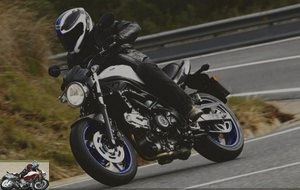
Part-cycle
Are the best soups in old pots? Probably ! Still, the Gladius chassis, in general, has been renewed for this new SV. In the frame, a little bit of material has been removed here and there to scrape off some weight, while the suspensions benefit from a subtly different setting..
Note that the SV 650 comes originally with first generation Dunlop Qualifier tires. While relatively safe in use, they do not help make driving rewarding.
The SV is aimed at young riders, they will discover a machine that is safe, healthy, maneuverable and rigid enough to have fun for a long time and that’s the main point. More experienced and demanding riders will certainly be more critical of the tuning of attack suspensions and braking power..
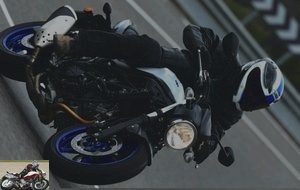
Brakes
The SV has a 298mm diameter twin disc at the front clamped by 2-piston calipers and a single disc at the rear. Here again, given the intended target, it is important that the braking is gradual and measurable: it is. Beginner riders will not be surprised with the controls that are perfectly easy to learn. It is a real asset in the city or on tricky back roads.
The braking power is very decent at the rear and average at the front: as a result, the ABS is not used too much and when it is, it is rather consistent in its operation..
Only demanding bikers will find the braking power quite limited when attacking.

Comfort / duo
To say that the major quality of OAS is its comfort is to push sycophancy to the frontiers of lying. Of course, the SV is low in the saddle and its ergonomics make it easy to use. In doing so, she sports a low saddle (and low stools are often fine); in addition, this saddle is quite deep and limits movement and changes of position in touring mode. As for the passenger, he sits on a fairly firm jump seat and does not have grab handles, while the suspensions do their job basically with firm compression and unrelenting rebound, especially at the rear..
So what ? The SV is a motorcycle for lunch, travel forms the youth and sore throat makes a philosopher. Objectively, nothing in the SV will prevent its young owners from devouring the road to build the foundations and the first layers of their biker identity.

Consumption
The work carried out on the engine (new segments, new pistons treated in resin, new airbox, new exhaust) Euro IV allows Suzuki to claim an average consumption of 3.84 l / 100, which gives a respectable autonomy of 360 km with the 13.8 liter tank. At the end of this test, which was carried out at a good pace but under difficult conditions, the on-board computer indicated 5.5 l / 100. It will be necessary to perform a second long-term test under more normal conditions to verify the actual consumption of the SV and confirm its claimed sobriety.
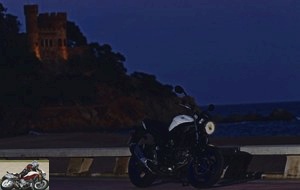
Conclusion
With the SV 650, Suzuki goes back to its fundamentals: first, a legendary name. Second, a no-frills bike, an essential machine, a bit out of fashion and refocusing on the core of the bike: an engine, feel and some interesting gear. Third: the price? In the past, made the price one of its strong arguments, but the SV 650 2016 is right in the heart of the market, at 6,599 € in France, even if lower prices are announced in Germany. As a reminder, a Yamaha MT-07 ABS costs € 6,699 and a Kawasaki Er-6n ABS costs € 6,499. The debate is settled between those who consider the SV 650 a little dated with its old updated recipe and those who see it as deliciously timeless, but the former may find its price a little high in view of the finish, the fit. tire or braking power, although the Suzuki is the only one in its segment to receive Euro IV approval.
To these, the SV responds with its major asset: the pleasure and performance of its V-Twin, quite real, against the vertical twin cylinders of the competition with less rich personality. Let’s not forget that a motorcycle is also (and especially, sometimes) an engine.
Strong points
- Lively and pleasant engine
- Overall homogeneity
- Complete dashboard
- Sympathetic Low RPM Assist
- Mythical SV name
- "Real" motorcycle neither retro nor bobo nor futuro
Weak points
- Firm comfort
- Average braking
- Medium finish
- Granting of suspensions to attack
- Price a bit high
The technical sheet of the SV 650 2016
Test conditions
- Route: 170 km of small roads around Lloret del Mar (Spain). Difficult conditions with wet roads, rain, thunderstorm and hail.
- Motorcycle mileage: 260 km
- Problem encountered: hail hurts hands and knees.
Competition: Kawasaki Er-6n, Yamaha MT-07, Hyosung 650 Comet, Honda CB 650 F, Aprilia 750 Shiver.
Related articles
-
Triumph Tiger Explorer 1200 test
A tiger with long teeth It’s no secret at Triumph, the Tiger Explorer is all about rocking the BMW R 1200 GS from its pedestal. A three-cylinder with…
-
Light is Right ! The little Duke 390 is an amazing machine. Ultra light and very powerful without being radical, it comes to hunt on the lands of the…
-
Harley-Davidson VR 1000 motorcycle test
The first American superbike 60 ° V-Twin of 996 cm3, 135 hp and 107 Nm, 177 kg, 50 units produced 1995! 25 years ago! This date is a major milestone for…
-
497 cc, 82 hp, 190 km / h, the first mass-produced turbo motorcycle A Power Ranger look for an expensive but efficient grand tourer The turbo , it’s a…
-
Harley-Davidson LiveWire electric motorcycle test
0 – 100 km / h in 3 seconds … Revolution… Revelation electric motor, 105 hp and 116.6 Nm, 249 kg, adjustable Showa suspensions, 150 km of range, from…
-
Kawasaki Z H2 Supercharged motorcycle test
200 hp, 14 mkg at 8,500 rpm, 239 kg all full, 17,099 € Put some salt ! Fifteen days of driving with the Kawasaki Z H2? I say it bluntly, it takes less to…
-
Suzuki 600 Bandit N motorcycle test
The day starts well … beautiful sun. In short, the ideal weather for ride the new Bandit 600 and swap my Bandit 600 S for the Bandit 600N of the 2000…
-
Test MV Agusta Turismo Veloce 800 Lusso SCS
A very high-end and very techno vision of fast tourism 3 cylinders in line, 798 cm3, 110 hp at 10,150 rpm, 80 Nm at 7100 rpm, 192 kilos, € 21,490 Be…
-
Birthday 4 cylinders in line, 1000 cm3, 202 hp, 117 Nm, 203 kg all full facts, 19,599 euros. Nice idea to resuscitate the R version of the GSX-R (the…
-
The first two-stroke of the Grands Prix 500 3-cylinder engine, 498 cm3, 82 hp and 59 Nm, 134 kg dry Ironic, really. Of the four Japanese manufacturers,…
Um, she’ll have to have character, it looks so much like a Japanese …, which were designed to look like the English … back then!
For the equipment of the old "basic" motorcycles, I would point out that a 400 Bandit in 93 (the second versions, never had the first) had in series (because the options were for cars) a guard. rear mud, which we call today, a central stand, a rubber protection for the axis of the clutch lever, a choke on the handlebars (which my TRX of another price did not even have in 96), and a protective grid on the radiator.
And it was entry level, simple and badly finished.
Ok, with that it had a damping to make people laugh and it would rust while sleeping outside, but since how long the motorcycles do not have these kind of little touches??
The optional passenger grips take the concept of ridiculously small and unusable seats to the end, after all..
What jumps out at me about this bike is its front fender which is just there to add some color. It is therefore not intended to ride in the rain or on gravel this bike…
It’s not like we can see the radiator just above without a grille to protect it.
I quibble but on a daily basis …
Fift are you sure how much you paid for OAS 15 years ago? I have a little doubt because it is the current price!